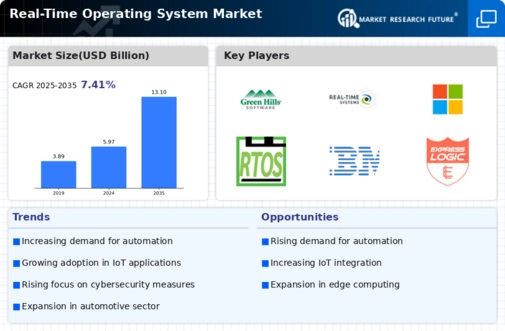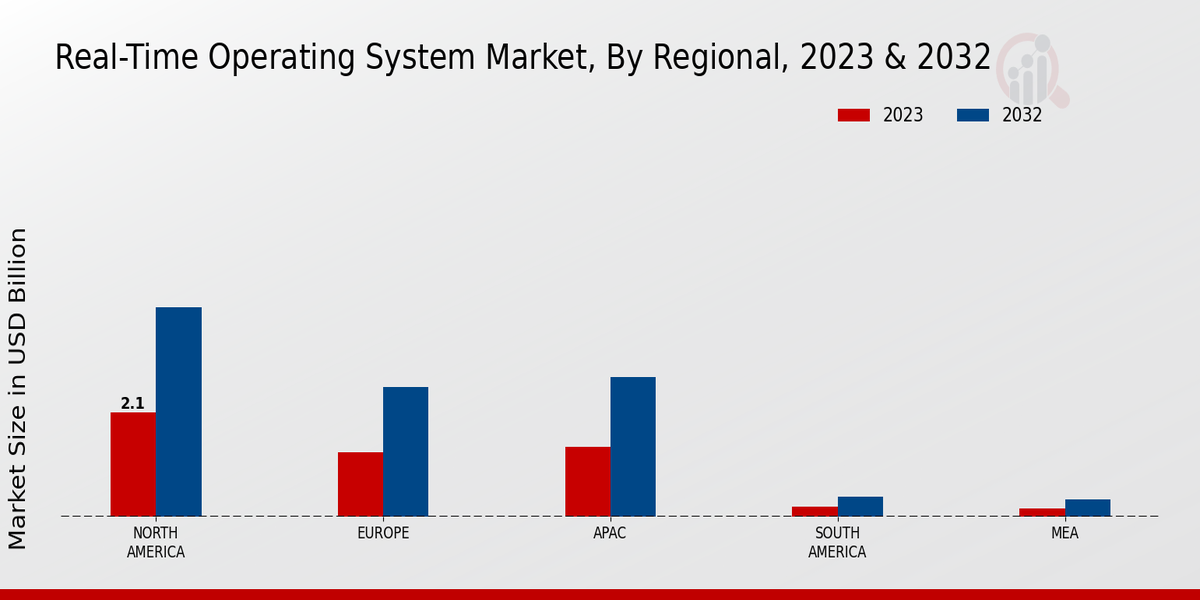Market Growth Projections
The Global Real-Time Operating System Market Industry is poised for substantial growth, with projections indicating a market size of 5.97 USD Billion in 2024 and an anticipated increase to 13.1 USD Billion by 2035. This growth trajectory suggests a compound annual growth rate of 7.42% from 2025 to 2035. Various factors, including the increasing demand for automation, the rise of IoT applications, and advancements in embedded systems, contribute to this positive outlook. The market's expansion reflects the critical role that real-time operating systems play in enabling timely and efficient processing across diverse industries.
Growth in IoT Applications
The proliferation of Internet of Things (IoT) devices is a key driver for the Global Real-Time Operating System Market Industry. IoT applications require real-time processing capabilities to manage vast amounts of data generated by interconnected devices. Real-time operating systems provide the necessary framework to ensure timely data processing and response, which is critical for applications in smart homes, healthcare, and industrial automation. As the number of IoT devices continues to rise, the demand for real-time operating systems is anticipated to grow, supporting the market's expansion towards an estimated 13.1 USD Billion by 2035.
Emergence of Edge Computing
The rise of edge computing is reshaping the landscape of the Global Real-Time Operating System Market Industry. Edge computing facilitates data processing closer to the source, reducing latency and improving response times. Real-time operating systems are crucial for managing the complexities of edge devices, which often require immediate processing capabilities. As organizations increasingly adopt edge computing solutions to enhance operational efficiency, the demand for real-time operating systems is likely to grow. This shift may contribute to a compound annual growth rate of 7.42% from 2025 to 2035, reflecting the market's potential for expansion.
Advancements in Embedded Systems
The Global Real-Time Operating System Market Industry is significantly influenced by advancements in embedded systems technology. Embedded systems are integral to various applications, including automotive control systems, consumer electronics, and medical devices. Real-time operating systems enable these systems to perform tasks with strict timing constraints, ensuring reliability and safety. As technology evolves, the complexity of embedded systems increases, necessitating more sophisticated real-time operating systems. This trend is likely to drive market growth, as industries increasingly rely on embedded solutions to enhance functionality and performance.
Increasing Demand for Automation
The Global Real-Time Operating System Market Industry experiences a surge in demand for automation across various sectors, including manufacturing, automotive, and telecommunications. Automation enhances operational efficiency and reduces human error, leading to increased productivity. For instance, industries are increasingly adopting automated systems that rely on real-time data processing, which is facilitated by real-time operating systems. This trend is expected to contribute significantly to the market's growth, with projections indicating that the market will reach 5.97 USD Billion in 2024. As organizations seek to streamline operations, the demand for robust real-time operating systems is likely to intensify.
Rising Need for Safety and Security
The increasing emphasis on safety and security in critical applications propels the Global Real-Time Operating System Market Industry forward. Industries such as aerospace, automotive, and healthcare are adopting real-time operating systems to ensure compliance with stringent safety standards. These systems provide deterministic behavior, which is essential for applications where failure is not an option. As regulatory frameworks become more rigorous, the demand for real-time operating systems that can meet these requirements is expected to rise. This trend underscores the importance of reliability in safety-critical applications, further driving market growth.



















